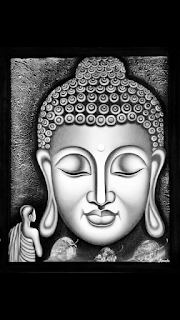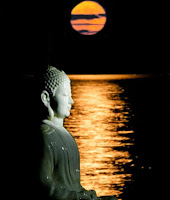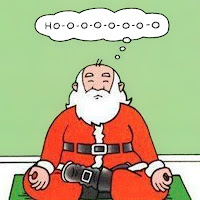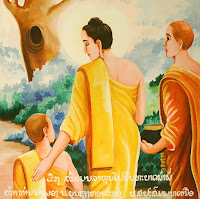Then early in the morning, the Blessed One put on his robes and, carrying his bowl and upper robe, went into Savatthi for alms. Having gone on alms round in Savatthi, after his meal, he said to Ven. Rahula, "Fetch your sitting cloth, Rahula. We will go to the Blindman's Grove to spend the day."
Responding, "As you say, venerable sir," Rahula carried his sitting cloth and followed the Blessed One. Now at that time, many thousands of
devas (lit. "shining ones," woodland fairies, nature spirits, space beings) were following behind the Blessed One [thinking,] "Today the Blessed One will lead Ven. Rahula further along to the ending of the
mental defilements (
kilesas)."
Then the Blessed One plunged into the Blindman's Grove and sat down at a seat made ready at the foot of a tree. Ven. Rahula, having bowed, sat respectfully to one side.
Teaching

As he was sitting there, the Blessed One said: "What do you think, Rahula -- is the eye constant or inconstant?"
- "Constant or inconstant": permanent or impermanent, reliable or unreliable, steady or in flux.
"
Inconstant, venerable sir."
"And is what is inconstant easy or
painful?"
"Painful, venerable sir."
"And is it fitting to regard what is inconstant, painful, and subject to change as, 'This is mine. This is my self. This I am'?"
"No, venerable sir."
"What do you think -- are forms constant or inconstant?"
"Inconstant, venerable sir."
"And is what is inconstant easy or painful?"
"Painful, venerable sir."
"And is it fitting to regard what is inconstant, painful, subject to change as, 'This is mine. This is my self. This I am'?"
"No, venerable sir."
"What do you think — is
consciousness of the eye constant or inconstant?"
"Inconstant, venerable sir."
"And is what is inconstant easy or painful?"
"Painful, venerable sir."
"And is it fitting to regard what is inconstant, painful, subject to change as, 'This is mine. This is my self. This I am'?"
"No, venerable sir."
"What do you think — is
contact of the eye constant or inconstant?"
"Inconstant, venerable sir."
"And is what is inconstant easy or painful?"
"Painful, venerable sir."
"And is it fitting to regard what is inconstant, painful, subject to change as, 'This is mine. This is my self. This I am'?"
"No, venerable sir."
"What do you think — whatever
arises in dependence on contact of the eye as a mode of sensation, a mode of perception, a mode of fabrication (
formation), or a mode of consciousness,* is it constant or inconstant?"
- *The Buddha's basic approach in this sutra is to take a line of questioning that he usually applies to the Five Aggregates clung to as self (see SN 22.59) and to apply it to the framework of the six senses (the five senses plus mind as the sixth) as given in SN 35.28. This phrase, however, is the one point where this discourse deviates from that framework. The corresponding phrase in SN 35.28 focuses exclusively on sensations (feelings). The passage here -- vedanagatam, saññagatam, sankharagatam, viññanagatam -- focuses on all four mental aggregates. For another example of translating -gatam as "mode," see the phrase "mode of perception" (saññagatam) in MN 121.
"Inconstant, venerable sir."
"And is what is inconstant easy or painful?"
"Painful, venerable sir."
"And is it fitting to regard what is inconstant, painful, and subject to change as, 'This is mine. This is my self. This I am'?"
"No, venerable sir."
 |
| I asked dad for my inheritance, and boy did he give it to me. Ordain with us, mother! |
.
"What do you think, Rahula — is the ear constant or inconstant?"
"Inconstant, venerable sir"...
"What do you think, Rahula — is the nose constant or inconstant?"
"Inconstant, venerable sir"...
"What do you think, Rahula — is the tongue constant or inconstant?"
"Inconstant, venerable sir"...
"What do you think, Rahula — is the body constant or inconstant?"
"Inconstant, venerable sir"...
"What do you think, Rahula — is mind constant or inconstant?"
"Inconstant, venerable sir."
"And is what is inconstant easy or painful?"
"Painful, venerable sir."
"And is it fitting to regard what is inconstant, painful, and subject to change as, 'This is mine. This is my self. This I am'?"
"No, venerable sir."
"What do you think — are mind objects (e.g., impressions, ideas) constant or inconstant?"
"Inconstant, venerable sir."
"And is what is inconstant easy or painful?"
"Painful, venerable sir."
"And is it fitting to regard what is inconstant, painful, and subject to change as, 'This is mine. This is my self. This I am'?"
"No, venerable sir."
"What do you think — is consciousness of the mind [apart from the five consciousnesses of the senses] constant or inconstant?"
"Inconstant, venerable sir."
"And is what is inconstant easy or painful?"
"Painful, venerable sir."
"And is it fitting to regard what is inconstant, painful, and subject to change as, 'This is mine. This is my self. This I am'?"
"No, venerable sir."
"What do you think — is mental contact constant or inconstant?"
"Inconstant, venerable sir."
"And is what is inconstant easy or painful?"
"Painful, venerable sir."
"And is it fitting to regard what is inconstant, painful, and subject to change as, 'This is mine. This is my self. This I am'?"
"No, venerable sir."
"What do you think — whatever arises in dependence on contact of the mind as a mode of sensation, a mode of perception, a mode of fabrication, or a mode of consciousness, is it constant or inconstant?"
"Inconstant, venerable sir."
"And is what is inconstant easy or painful?"
"Painful, venerable sir."
"And is it fitting to regard what is inconstant, painful, and subject to change as, 'This is mine. This is my self. This I am'?"
"No, venerable sir."
"Seeing this, Rahula, a well-instructed disciple of
the noble ones grows disenchanted with the eye, disenchanted with forms (perceived by the eye), disenchanted with eye consciousness [arising dependent on the eye and forms], disenchanted with contact [of these three] at the eye.
"And whatever arises in dependence on contact at the eye as a mode of feeling, a mode of perception, a mode of fabrication, or a mode of consciousness, with that one also grows disenchanted.
"One grows disenchanted with the ear...
"One grows disenchanted with the nose...
"One grows disenchanted with the tongue...
"One grows disenchanted with the body...
"One grows disenchanted with the mind, disenchanted with mind-objects (impressions, ideas), disenchanted with mental consciousness, disenchanted with contact at the mind.
"And whatever arises in dependence on mental contact as a mode of feeling, a mode of perception, a mode of fabrication, or a mode of consciousness, with that one also grows disenchanted.
"Disenchanted, one becomes dispassionate. Through dispassion, one is fully liberated (released, freed, emancipated). With full liberation comes the knowledge, 'Fully liberated.'
"One discerns that, 'Rebirth is exhausted, the supreme life fulfilled, the task done; there is nothing further for this world.'"
That is what the Blessed One said. Gratified, Ven. Rahula delighted in the Blessed One's words. And while this explanation was being given, Ven. Rahula's mind, by letting go and no longer clinging (not being sustained), was fully released from the defilements.
And for the many thousands of shining ones (
devas) listening there arose the dustless and stainless eye of the Dharma: "Whatever is subject to arising is all subject to cessation as well."











































































































































































































































































